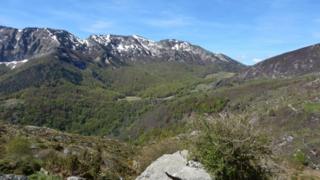
Image copyright
Strathclyde University
Researchers found the secluded area in the Pyrenees mountains was covered with airborne microplastics
Scientists have found that a secluded region in the Pyrenees mountains – previously considered pristine wilderness – is covered with airborne microplastics.
A team from Strathclyde and Toulouse universities spent five months in the area, which straddles France and Spain.
They estimate that each day an average of 365 tiny plastic fragments or fibres settled on every square metre of land.
The nearest major city – Toulouse – is about 75 miles away.
Researchers collected samples from what they considered to be an uncontaminated area in south west France, about four miles from the nearest village.
Samples from monitoring devices were analysed to identify whether the tiny plastic pieces, invisible to the naked eye and less than five millimetres long, were present in the mountain range.
It is not known the distance microplastics can travel, but the paper, published in the Nature Geoscience journal, suggests fragments are regularly travelling distances of nearly 60 miles.
Image copyright
Strathclyde University
Steve Allen and the team of researchers spent five months studying microplastics in the region
Steve Allen, a researcher from Strathclyde University, said the research suggested microplastics were being transported by the wind.
He said: “It’s astounding and worrying that so many particles were found in the Pyrenees field site.
“It opens up the possibility that it’s not only in the cities you are breathing this in, but it can travel quite some distance from the sources.
“Plastic litter is an increasing global issue and one of the key environmental challenges we face on global scale.”
Mr Allen said that researchers had yet to determine the full impact of microplastics, but that other experiments had suggested they could lead to changes in feeding and mating habits in some species.
Microplastics, which are completely invisible to the naked eye, have also been detected in the oceans and aquatic life.
They have been found in tap water around the world and in some of the most remote places on earth, with studies showing they have even reached Antarctica.
